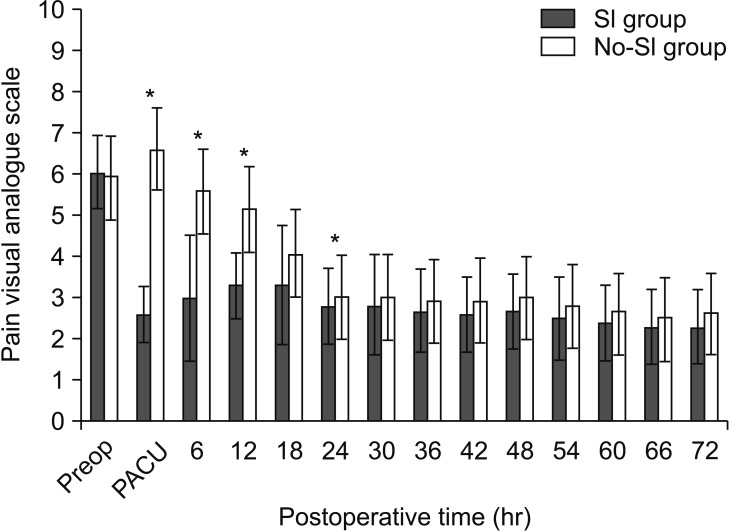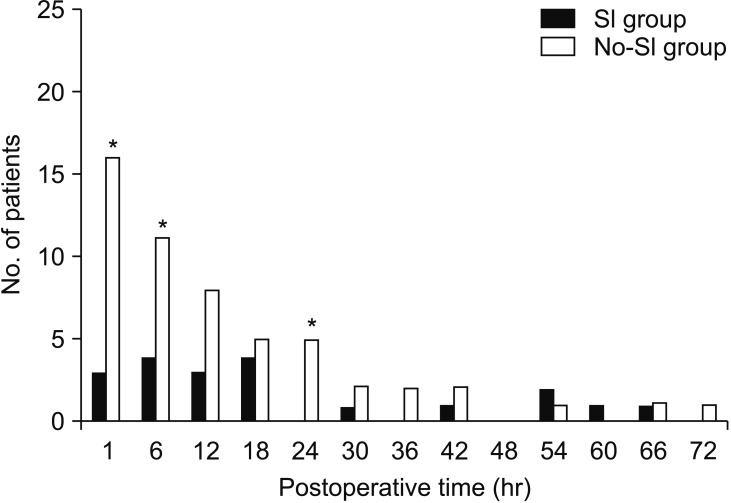Clin Orthop Surg.
2018 Dec;10(4):455-461. 10.4055/cios.2018.10.4.455.
Effect of Surgical-Site, Multimodal Drug Injection on Pain and Stress Biomarkers in Patients Undergoing Plate Fixation for Clavicular Fractures
- Affiliations
-
- 1Department of Orthopedic Surgery, Dankook University College of Medicine, Cheonan, Korea. ssjb1990@dku.edu
- KMID: 2426531
- DOI: http://doi.org/10.4055/cios.2018.10.4.455
Abstract
- BACKGROUND
Surgical-site, multimodal drug injection has recently evolved to be a safe and useful method for multimodal pain management even in patients with musculoskeletal trauma.
METHODS
Fifty consecutive patients who underwent plating for mid-shaft and distal clavicular fractures were included in the study. To evaluate whether surgical-site injections (SIs) have pain management benefits, the patients were divided into two groups (SI and no-SI groups). The injection was administered between the deep and superficial tissues prior to wound closure. The mixture of anesthetics consisted of epinephrine hydrochloride (HCL), morphine sulfate, ropivacaine HCL, and normal saline. The visual analogue scale (VAS) pain scores were measured at 6-hour intervals until postoperative hour (POH) 72; stress biomarkers (dehydroepiandrosterone sulfate [DHEA-S], insulin, and fibrinogen) were measured preoperatively and at POH 24, 48, and 72. In patients who wanted further pain control or had a VAS pain score of 7 points until POH 72, 75 mg of intravenous tramadol was administered, and the intravenous tramadol requirements were also recorded. Other medications were not used for pain management.
RESULTS
The SI group showed significantly lower VAS pain scores until POH 24, except for POH 18. Tramadol requirement was significantly lower in the SI group until POH 24, except for POH 12 and 18. The mean DHEA-S level significantly decreased in the no-SI group (74.2 ± 47.0 µg/dL) at POH 72 compared to that in the SI group (110.1 ± 87.1 µg/dL; p = 0.046). There was no significant difference in the insulin and fibrinogen levels between the groups. The correlation values between all the biomarkers and VAS pain scores were not significantly different between the two groups (p > 0.05).
CONCLUSIONS
After internal fixation of the clavicular fracture, the surgical-site, multimodal drug injection effectively relieved pain on the day of the surgery without any complications. Therefore, we believe that SI is a safe and effective method for pain management after internal fixation of a clavicular fracture.
Keyword
MeSH Terms
Figure
Reference
-
1. NEER CS 2nd. Nonunion of the clavicle. J Am Med Assoc. 1960; 172:1006–1011. PMID: 14426324.
Article2. Webber MC, Haines JF. The treatment of lateral clavicle fractures. Injury. 2000; 31(3):175–179. PMID: 10704582.
Article3. McKee RC, Whelan DB, Schemitsch EH, McKee MD. Operative versus nonoperative care of displaced midshaft clavicular fractures: a meta-analysis of randomized clinical trials. J Bone Joint Surg Am. 2012; 94(8):675–684. PMID: 22419410.
Article4. van der Linde RA, Beetz I, van Helden SH. Plating for midshaft clavicular fractures: the impact on quality of life and functional outcome. Injury. 2017; 48(12):2778–2783. PMID: 29100661.
Article5. Daniilidis K, Raschke MJ, Vogt B, et al. Comparison between conservative and surgical treatment of midshaft clavicle fractures: outcome of 151 cases. Technol Health Care. 2013; 21(2):143–147. PMID: 23510974.
Article6. George DM, McKay BP, Jaarsma RL. The long-term outcome of displaced mid-third clavicle fractures on scapular and shoulder function: variations between immediate surgery, delayed surgery, and nonsurgical management. J Shoulder Elbow Surg. 2015; 24(5):669–676. PMID: 25457191.
Article7. Oh JH, Rhee KY, Kim SH, Lee PB, Lee JW, Lee SJ. Comparison of analgesic efficacy between single interscalene block combined with a continuous intra-bursal infusion of ropivacaine and continuous interscalene block after arthroscopic rotator cuff repair. Clin Orthop Surg. 2009; 1(1):48–53. PMID: 19884997.8. Ciccone WJ 2nd, Busey TD, Weinstein DM, Walden DL, Elias JJ. Assessment of pain relief provided by interscalene regional block and infusion pump after arthroscopic shoulder surgery. Arthroscopy. 2008; 24(1):14–19. PMID: 18182196.
Article9. Valdes-Vilches LF, Sanchez-del Aguila MJ. Anesthesia for clavicular fracture: selective supraclavicular nerve block is the key. Reg Anesth Pain Med. 2014; 39(3):258–259. PMID: 24747317.10. Ueshima H, Otake H. Successful clavicle fracture surgery performed under selective supraclavicular nerve block using the new subclavian approach. JA Clin Rep. 2016; 2(1):34. PMID: 29492429.
Article11. Tran DQ, Tiyaprasertkul W, Gonzalez AP. Analgesia for clavicular fracture and surgery: a call for evidence. Reg Anesth Pain Med. 2013; 38(6):539–543. PMID: 24121609.12. Joshi GP. Multimodal analgesia techniques and postoperative rehabilitation. Anesthesiol Clin North America. 2005; 23(1):185–202. PMID: 15763418.
Article13. Phillips DM. JCAHO pain management standards are unveiled: Joint Commission on Accreditation of Healthcare Organizations. JAMA. 2000; 284(4):428–429. PMID: 10904487.14. Parvataneni HK, Shah VP, Howard H, Cole N, Ranawat AS, Ranawat CS. Controlling pain after total hip and knee arthroplasty using a multimodal protocol with local periarticular injections: a prospective randomized study. J Arthroplasty. 2007; 22(6 Suppl 2):33–38. PMID: 17823012.
Article15. Webb D, Guttmann D, Cawley P, Lubowitz JH. Continuous infusion of a local anesthetic versus interscalene block for postoperative pain control after arthroscopic shoulder surgery. Arthroscopy. 2007; 23(9):1006–1011. PMID: 17868841.
Article16. Liu XN, Noh YM, Yang CJ, Kim JU, Chung MH, Noh KC. Effects of a single-dose interscalene block on pain and stress biomarkers in patients undergoing arthroscopic rotator cuff repair: a randomized controlled trial. Arthroscopy. 2017; 33(5):918–926. PMID: 27988164.
Article17. Desborough JP. The stress response to trauma and surgery. Br J Anaesth. 2000; 85(1):109–117. PMID: 10927999.
Article18. Freitas RP, Lemos TM, Spyrides MH, Sousa MB. Influence of cortisol and DHEA-S on pain and other symptoms in post menopausal women with fibromyalgia. J Back Musculoskelet Rehabil. 2012; 25(4):245–252. PMID: 23220807.19. Uchida I, Asoh T, Shirasaka C, Tsuji H. Effect of epidural analgesia on postoperative insulin resistance as evaluated by insulin clamp technique. Br J Surg. 1988; 75(6):557–562. PMID: 3293693.
Article20. Longo UG, Petrillo S, Berton A, et al. Role of serum fibrinogen levels in patients with rotator cuff tears. Int J Endocrinol. 2014; 2014:685820. PMID: 24817887.
Article21. Robinson CM, Goudie EB, Murray IR, et al. Open reduction and plate fixation versus nonoperative treatment for displaced midshaft clavicular fractures: a multicenter, randomized, controlled trial. J Bone Joint Surg Am. 2013; 95(17):1576–1584. PMID: 24005198.22. Chung MS, Roh YH, Baek GH, Lee YH, Rhee SH, Gong HS. Evaluation of early postoperative pain and the effectiveness of perifracture site injections following volar plating for distal radius fractures. J Hand Surg Am. 2010; 35(11):1787–1794. PMID: 20961701.
Article23. Busch CA, Shore BJ, Bhandari R, et al. Efficacy of periarticular multimodal drug injection in total knee arthroplasty: a randomized trial. J Bone Joint Surg Am. 2006; 88(5):959–963. PMID: 16651569.24. Vendittoli PA, Makinen P, Drolet P, et al. A multimodal analgesia protocol for total knee arthroplasty: a randomized, controlled study. J Bone Joint Surg Am. 2006; 88(2):282–289. PMID: 16452738.25. Sanzone AG. Current challenges in pain management in hip fracture patients. J Orthop Trauma. 2016; 30(Suppl 1):S1–S5.
Article26. Sinatra RS, Torres J, Bustos AM. Pain management after major orthopaedic surgery: current strategies and new concepts. J Am Acad Orthop Surg. 2002; 10(2):117–129. PMID: 11929206.
Article27. Koehler D, Marsh JL, Karam M, Fruehling C, Willey M. Efficacy of surgical-site, multimodal drug injection following operative management of femoral fractures: a randomized controlled trial. J Bone Joint Surg Am. 2017; 99(6):512–519. PMID: 28291185.28. Jiang J, Teng Y, Fan Z, Khan MS, Cui Z, Xia Y. The efficacy of periarticular multimodal drug injection for postoperative pain management in total knee or hip arthroplasty. J Arthroplasty. 2013; 28(10):1882–1887. PMID: 23910819.
Article29. Kang H, Ha YC, Kim JY, Woo YC, Lee JS, Jang EC. Effectiveness of multimodal pain management after bipolar hemiarthroplasty for hip fracture: a randomized, controlled study. J Bone Joint Surg Am. 2013; 95(4):291–296. PMID: 23302898.30. Oh JH, Kim WS, Kim JY, Gong HS, Rhee KY. Continuous intralesional infusion combined with interscalene block was effective for postoperative analgesia after arthroscopic shoulder surgery. J Shoulder Elbow Surg. 2007; 16(3):295–299. PMID: 17321159.
Article31. Buyukkocak U, Daphan C, Caglayan O, et al. Effects of different anesthetic techniques on serum leptin, C-reactive protein, and cortisol concentrations in anorectal surgery. Croat Med J. 2006; 47(6):862–868. PMID: 17167859.32. Finset A, Overlie I, Holte A. Musculo-skeletal pain, psychological distress, and hormones during the menopausal transition. Psychoneuroendocrinology. 2004; 29(1):49–64. PMID: 14575729.
Article33. Rizvi AA, Chillag SA, Chillag KJ. Perioperative management of diabetes and hyperglycemia in patients undergoing orthopaedic surgery. J Am Acad Orthop Surg. 2010; 18(7):426–435. PMID: 20595135.
Article34. Jamsen E, Nevalainen PI, Eskelinen A, Kalliovalkama J, Moilanen T. Risk factors for perioperative hyperglycemia in primary hip and knee replacements. Acta Orthop. 2015; 86(2):175–182. PMID: 25409255.
- Full Text Links
- Actions
-
Cited
- CITED
-
- Close
- Share
- Similar articles
-
- Hypoesthesia after Open Reduction and Plate Fixation of Clavicular Midshaft Fractures: Correlation with Plate Location and Clinical Features of Hypoesthesia
- Results of Hook Plate Fixation of Unstable Distal Clavicle Fractures
- Management of Clavicular Shaft Fracture with Open Reduction and Internal Fixation
- Effect of Ropivacaine Local Injection According to Depth in Clavicular Surgery
- The Operative Treatment of Nonunions of Midshaft Clavicular Fractures: Reconstruction Plate Fixation and Bone Grafting




